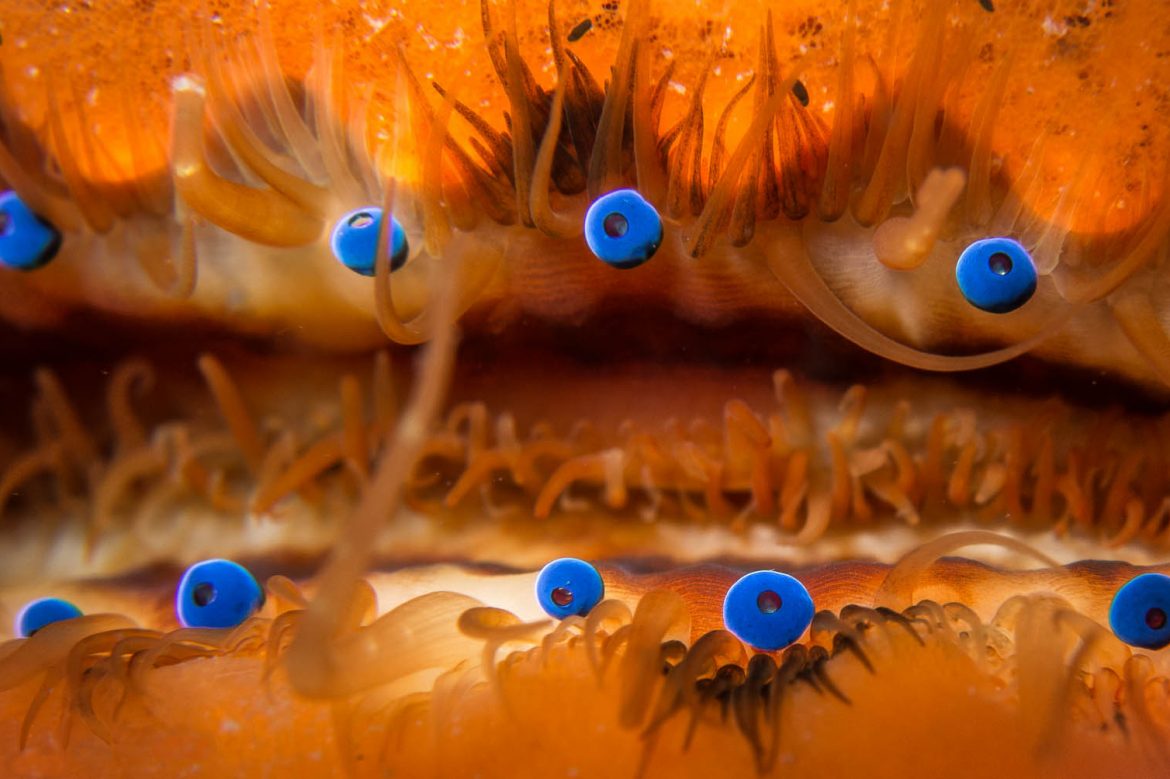
Mirror, Mirror, Show Me!
Scallops are among delicacies of the Mediterranean cuisine. But did you know the mantle lining their shells has up to 200 eyes, which they use like a microscope to understand what is going on around them?
The vision ability of these crustaceans is a new subject of research. These eyes respond to light, but their optics are quite different from the ocular organs we know, and thus we will probably never be able to understand exactly what they see, or what they perceive with these eyes. Biologically speaking, light entering one of these eyes first passes through a pupil, then through a lens and two different retinas, reaching a hemispherical mirror at the back of the eye. The light reflects from this mirror and is focused on the interior surface of the retinas, which triggers a group of nerve cells. Although much is written on the visual ability of scallops these days, the main feature of interest is the similarity of their eyes to the optical systems used in advanced telescopes.
Swiss scientists are developing a new microscope lens inspired by both astronomical telescopes and the eyes of scallops. The use of mirrors instead of lenses is very common in telescopes, as it is critical to capture as much light as possible in the darkness of outer space. For example, the telescope developed by Bernhard Schmidt in the 1930s works with a large spherical mirror and a thin correcting lens and is still used in many observatories today.
In microscopes, however, lenses are preferred. Microscope lenses are very small, but complex and expensive, and generally designed for use in a single immersion medium: air, water, or oil –meaning you need a separate objective for each different medium. This has become problematic since the development of a new technique that makes tissue samples transparent because the medium used in this technique does not match conventional microscope lenses. The technique eliminates the need to prepare very thin slices out of a mouse brain –as the conventional method requires- as it can make the brain completely transparent. However, due to lens incompatibility issues, its full potential is yet to be utilized even though it offers significant benefits in biopsy examinations or detection of malignant tumors.
Scientists from the University of Zurich found the possibility of filling a conventional Schmidt telescope with a liquid immersion medium and producing it in a microscope size. According to neuroscientist and amateur astronomer Dr. Fabian Voigt, “It is possible to design a Schmidt objective in a way that it provides excellent image quality in any homogeneous fluid as well as in air.” This way, a single lens can be used with multiple different clearing techniques. What makes this possible is using a mirror instead of lenses. A spherical mirror in the microscope focuses the light at the same point in liquid and in the air (remember the scallop eye).
Professor Fritjof Helmchen from the University of Zurich says “In all cases, the image quality was equivalent to or even better than that achievable with conventional objectives—even though the Schmidt objective consists of only two optical elements.” Moreover, the manufacture can be cheaper as it will not require using a large number of lenses as is the conventional objective.
Dr. Voigt and his colleagues have already used a prototype of this new microscope to examine a variety of samples including mouse brains, tadpoles, and chicken embryos. They were also able to examine cleared human brain samples and observe neural activity in the zebrafish brain.
A different approach to technology allows for the development of brand-new techniques with a biomimicry point of view. Hopefully, as such approaches increase, the opportunities to conduct scientific studies in easier and more cost-effective ways will also increase.
For a pleasant read that gives more insight into what we know and don’t know about the senses of animals, we recommend Ed Yong’s popular science book “An Immense World: How Animal Senses Reveal the Hidden Realms Around Us”.
REFERENCES
- 1. https://www.smithsonianmag.com/science-nature/what-scallops-many-eyes-can-teach-us-about-evolution-vision-180972099/
- 2. https://phys.org/news/2023-03-scallop-eyes-microscope.html
